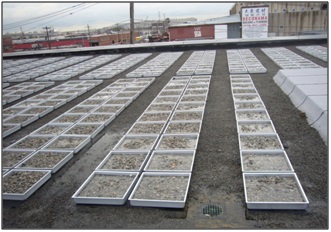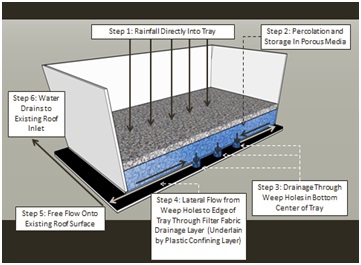Rooftop Detention (Blue Roofs)

Description
Rooftop detention, also known as a "blue roof", is designed to provide temporary storage and slow release of stormwater runoff. This technique is most commonly used in dense urban areas where other methods of stormwater detention are impractical.
Blue roofs are used to detain rooftop runoff onsite and reduce the rate of runoff from rooftops during rainfall events. A blue roof may be used as a stand-alone detention method or because they do little to improve the water quality of runoff, as part of a treatment train that includes other low impact development and conventional best management practices (BMPs) such as bioretention, infiltration, wetland systems, or green roofs to enhance the function, improve the performance, and reduce the cost of those approaches. The four primary blue roof types are described below:
Roof-Integrated Designs
Roof‐integrated designs are built during new construction or modifications of existing roofs to intentionally store standing water over extended periods. These designs utilize a roofing membrane or waterproofing system as the primary water detention structure. Water is temporarily ponded directly on the roof surface. Roof-integrated designs can be designed to store water either as an open water surface or within a porous media.
In addition, structures such as walkways, decks, or plazas can be constructed on top of roof integrated designs to minimize the impact of ponded water on roof access. Alternatively, porous media such as flexible paving tiles or granular media can be used as a permeable walking surface on all or part of the roof to allow for access, while reducing the amount of standing open water.
Roof‐integrated designs can be constructed as a secondary roofing layer on top of an existing surface in the same manner as a physical root barrier in green roof designs.

Modular Tray Designs
Modular tray systems use plastic trays to temporarily detain water during rainfall. This approach provides flexibility in both the size and configuration of the detention system and is well‐suited for retrofit designs. Rooftop equipment and structures can be avoided through selective placement of the trays. Loading issues can be addressed though optimal density and placement configurations. The trays can be physically attached to the roof or underlying supporting grid and/or held in place with ballast comprised of coarse stone or other weighed materials. The depth of the ballast or media contained in the trays can be varied depending on the desire to reduce the presence of open water surfaces.
Modular trays can have a variety of different outlet designs according to the goals of the installation (e.g., reduce peak flows, achieve specific lag time for target events, etc.). When water is released, the drainage system for the roof continues to function as it did prior to the retrofit (i.e., hydraulic head and flow depths on the roofing surface during rainfall are not increased).
Modular tray blue roof designs can be selectively mixed with green roof components to improve aesthetics and provide some of the additional benefits of green roofs. The most challenging component of blue roof try designs is the robustness of the hydraulic outlet design. Consistent and reliable drainage of the trays with little maintenance is a key consideration. Some designs allow for trays to be interconnected to effectively act as a larger "tank".
Roof-Dams/Roof-Checks
Roof‐dams or roof‐checks are impermeable or semi-permeable interim breaks in the surface flow paths installed on existing or new roofs, which allow water to pond behind them as temporary detention. The dams can incorporate specific overflow or outlet designs to slowly release the stored water. In the same manner as a roof‐integrated design, the roof is used as the primary water detention structure with the flows being restricted by the roof‐dams. If retrofit onto existing roofs, the ability of the roof to accept additional ponding should be assessed and addressed. In older roof installations, new roofing and additional water proofing may be needed in conjunction with the installation of the dams.

Actively Controlled Systems
Blue roofs that are used for temporary rooftop storage can be classified as "active" or "passive" depending on the types of control devices used to regulate drainage of water from the roof. Passive designs use hydraulic structures such as weirs, orifice plates or hydraulic regulators to control release rates from the roof. Active approaches allow for
the use of a valve configuration and controller to regulate discharge of flows from rooftops. The simplest design for an actively controlled blue roof is the retrofit or installation of a pneumatically or hydraulically actuated pinch valve on the roof leader drain pipe. This valve can be connected to a low cost micro‐controller, which monitors hydraulic head on the valve and timing of storage on the roof surface. The controller can be programmed to release the ponded water according to some predetermined optimal approach based on analysis of the receiving storm sewer, downstream BMP, or receiving water. More complex designs can integrate communications with server‐side and/or internet based data feeds, or telemetry to optimize release timing and quantities.
Advantages
- Often the least expensive means for temporarily storing storm water at a site, particularly when compared to subsurface storage or green roof systems.
- Can reduce the size and/or improve the performance of downstream BMPs, such as bioretention cells or infiltration systems.
- Easy to install – no additional excavation/construction required.
- Existing commercially available products for flow control.
- Readily coupled with other storage techniques, such as subsurface or surface storage.
Limitations
- Storage using outlet controls limited to flat roofs or roofs with shallow slopes (e.g., < 1 percent) due to increased ratio of ponding depth to available volume for steeper slopes. This problem can be addressed through the use of modular tray designs or roof‐dams.
- Limited benefit on sites where roof area makes up only a small portion of total impervious area.
- Regular maintenance varies by design, but is an important consideration. Verification of system performance may be necessary.
- Potential tampering must be considered in design.
Applications
Blue roofs can be implemented effectively on shallowly sloped roofs in residential, manufacturing, commercial or industrial settings. Rooftop detention is a particularly good storage option in densely developed areas where roofs make up a significant portion of the total site area.
Blue roofs are well‐suited to applications on commercial and residential buildings, which typically have large, flat roofs and little or no area available for storage on site surrounding the building. Such large roofs generate significant runoff quantities. Rooftop detention using blue roofs represents a cost-effective and convenient storage option that can be applied to new construction in the urban environment to provide adequate storage volume and runoff reduction to comply with stormwater regulations.
In addition to applications in densely developed areas, blue roof storage techniques also lend themselves well to implementation on sites with moderate to large flat roofs where flow from impervious non‐roof area (e.g. parking lots, walkways, etc.) also contributes to the total runoff. In these situations, blue roofs are used to control rooftop runoff, while subsurface BMPs are used to control runoff from non‐roof areas. The use of rooftop storage on such sites reduces the required volume for subsurface systems and allows these systems to be constructed over a smaller area.